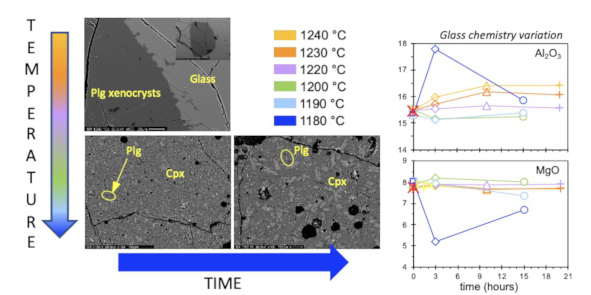Experimental cannibalization of plagioclase by alkaline basalt magmas
DOI:
https://doi.org/10.13133/2239-1002/17931Abstract
Time-series crystallization/dissolution experiments were conducted on a natural potassic basalt seeded with bytownitic plagioclases (Plg) at atmospheric pressure, in air, at 1180- 1240 °C and isothermal dwell time up to 20 hours. Plg-seed presence promotes the early formation of new-Plg, dampening the clinopyroxene (Cpx) crystallization. New-Plgs grow at a rate from 10-6 up to 10-8 cm·s-1 as the dwell time increases. Seeds overgrow at similar rate. Cpx crystallizes with a delay of at least 3 hours; this has a significant impact on the composition of both residual melt and new-Plgs. For undercooling >35 °C the Cpx delay causes a strong supersaturation of this phase in the melt resulting in a decrease in the new-Plg nucleation rate by 2 orders of magnitude in the 3 h-experiment. In the 15h-run, Cpx coarsening and the decrease of crystallinity suggest the achievement of a near-equilibrium conditions. Cpx growth rate is in the order of 10-7 cm·s-1 showing very limited variation. Finally, for the investigated superheating (5-15 °C) only the long lasting experiments allows an estimation of Plg dissolution rate (10-9 cm·s-1) although changes in the melt composition are already detectable in the 3h-runs.
As a whole our results suggest that in natural systems, the takeover of antecrysts/ xenocrysts by a magma can induce on a short time scales, changes in its initial nucleation behavior with remarkable petrological implications for the solidification paths and eruptive dynamics of potassic magmatic systems.

Downloads
Published
Issue
Section
License
Copyright (c) 2023 Periodico di Mineralogia

This work is licensed under a Creative Commons Attribution 4.0 International License.

